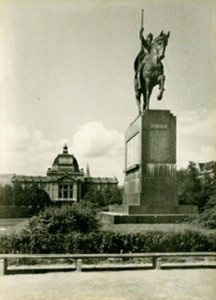 The position and status of art and artist changed considerably in Europe in the modern period, primarily with the formulation of the concept of artistic genius and the new division of labour that separated artists from artisans. Those dealing with art were looked upon as individuals possessing an extraordinary talent that transcended mere skill. Regardless of this new individuality, artistic genius cannot be equated with complete autonomy. Although no longer dependent upon brotherhoods and gilds, artistic practice was nevertheless tied to a wider social context.
The position and status of art and artist changed considerably in Europe in the modern period, primarily with the formulation of the concept of artistic genius and the new division of labour that separated artists from artisans. Those dealing with art were looked upon as individuals possessing an extraordinary talent that transcended mere skill. Regardless of this new individuality, artistic genius cannot be equated with complete autonomy. Although no longer dependent upon brotherhoods and gilds, artistic practice was nevertheless tied to a wider social context.
Political circumstances have always influenced artistic production to a greater or lesser extent. However, in the modern period, an increased significance was given to political bodies and legislative frameworks which introduced changes to social structures bringing thereby the need for artists to adapt to new situations. In addition to newly formed bourgeoisie, aristocracy and the church(es) which remained influential in the course of the 19th century, various political elites, and political bodies on both national and local levels, gradually assumed an important role as investors of architectural projects or patrons of artists and artworks in general.
By stimulating or influencing cultural transfers political structures greatly influenced the shaping of cultural circles in European countries.
Changes of political borders, social systems wars and economic instability are still continuously mirrored in the production of art, both formally and conceptually.
Social organization of artistic life has also been determined  by different spheres of political, cultural or economic interests. Professional associations, organisation and artist collectives, whose activities can range from utopian programmes to practical implementation of artistic ideas, either affirm or oppose political parties and/or systems. The same is the case with individual artists whose work can speak more or less openly about their personal position in relation to wider socio-political circumstances. Although rarely, they still manage to oppose regimes and enforced visual models in more or less subtle ways. Their personal criticism can be interpreted as at least an effort to undermine the power of oppressive ideologies.
by different spheres of political, cultural or economic interests. Professional associations, organisation and artist collectives, whose activities can range from utopian programmes to practical implementation of artistic ideas, either affirm or oppose political parties and/or systems. The same is the case with individual artists whose work can speak more or less openly about their personal position in relation to wider socio-political circumstances. Although rarely, they still manage to oppose regimes and enforced visual models in more or less subtle ways. Their personal criticism can be interpreted as at least an effort to undermine the power of oppressive ideologies.
 What of all these mere efforts or accomplishments stays recorded and conveyed to other generations is largely determined by museums. As institutions which either specialize in art or collect art as part of more diverse collections, museums often help determine, reinforce or disregard the value of individual art works, artists or certain aspects of art production. Collection and communication of art in these institutions, understood in the widest possible sense of the word, establish a dialogue between art production and the notion of quality, value, tradition and identity. By collecting art, which can be seen as an act of collective remembering, museums designate collected works as representatives of the material world that are worth keeping and protecting. By exhibiting, they transmit messages which are fraught with ideological meanings developed in specific political, economic and socio-cultural contexts. Through their basic functions, museums therefore indicate or clearly point out to specific relationships between art and ideology with what is present in their collections and shown in exhibitions as well as with what is absent.
What of all these mere efforts or accomplishments stays recorded and conveyed to other generations is largely determined by museums. As institutions which either specialize in art or collect art as part of more diverse collections, museums often help determine, reinforce or disregard the value of individual art works, artists or certain aspects of art production. Collection and communication of art in these institutions, understood in the widest possible sense of the word, establish a dialogue between art production and the notion of quality, value, tradition and identity. By collecting art, which can be seen as an act of collective remembering, museums designate collected works as representatives of the material world that are worth keeping and protecting. By exhibiting, they transmit messages which are fraught with ideological meanings developed in specific political, economic and socio-cultural contexts. Through their basic functions, museums therefore indicate or clearly point out to specific relationships between art and ideology with what is present in their collections and shown in exhibitions as well as with what is absent.
 The goal of the conference is to stress the social contexts of artistic production and to question and interpret social and historical circumstances that conditioned and influenced the creation, meaning and perception of works of art.
The goal of the conference is to stress the social contexts of artistic production and to question and interpret social and historical circumstances that conditioned and influenced the creation, meaning and perception of works of art.
The contributions to the scientific conference Art and Politics in Europe in the Modern Period should deal with different aspects of complex relationships between visual art and political, economic, cultural, gender and other politics in Europe in the period from the late 15th century to the present day. This can be addressed through one of the topics in the three topic areas.